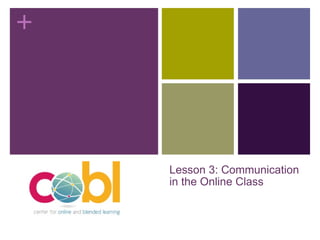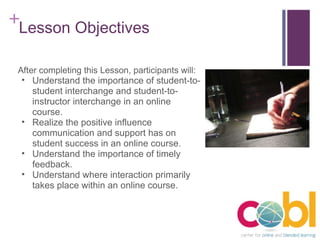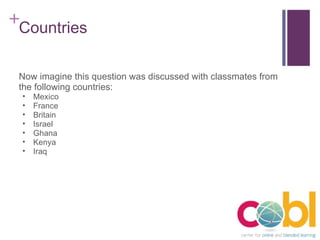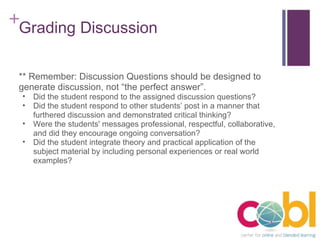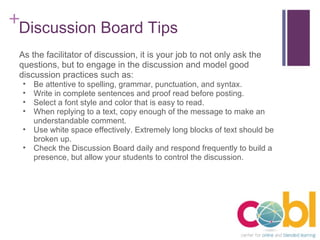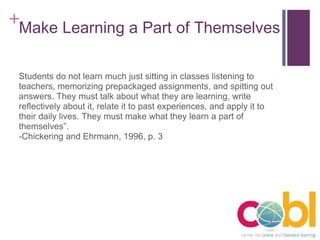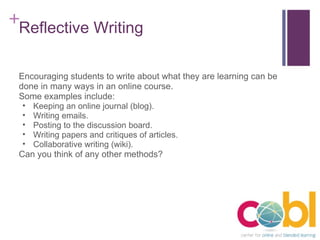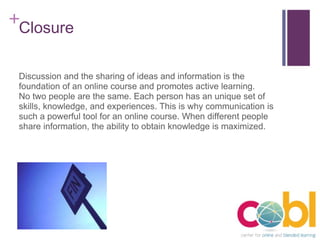OFT - pr3_communication
- 1. Lesson 3: Communication in the Online Class
- 2. Lesson Objectives After completing this Lesson, participants will: Understand the importance of student-to-student interchange and student-to-instructor interchange in an online course. Realize the positive influence communication and support has on student success in an online course. Understand the importance of timely feedback. Understand where interaction primarily takes place within an online course.
- 3. Importance of Communication The core of an online course is interaction. The Board of Trustees at the University of Illinois, 2003; Draves, 2002. Powerful learning and education takes place through student-to-student interchange and student-to-instructor interchange. Draves 2002; Palloff and Pratt 1999.
- 4. What does this Mean to You?
- 5. Countries Now imagine this question was discussed with classmates from the following countries: Mexico France Britain Israel Ghana Kenya Iraq
- 6. Unique Perspectives Can you imagine how each student's unique perspective could impact dialogue and enhance learning through an asynchronous (anytime, any place) discussion online? Thinking through this example should shed light on just one of the many ways that online communication is a central component to active learning.
- 7. Focus Questions Why is communication a central component to the online course? What are some of the ways you could encourage and promote discussion in your online course?
- 8. Online Interaction Online interaction can take place in many ways: discussion forums, chat rooms, email, video chats, blogs, wikis, and telephone if necessary. The most popular way to interact asynchronously online is through the Discussion Board Forums .
- 9. Set Discussion Expectations Instructors should set the expectations for discussion up front in the syllabus. For example: students should participate in discussion at least 3 days of the week and post 1-2 messages each of those days. In the syllabus, give examples of a quality Discussion Board post and a poor Discussion Board post. Give students the Discussion Board Rubric you will use to grade discussion board participation.
- 10. Value of Participation Think about the role of participation and the value it has in helping students understand and apply the concept on which they are learning. This will also help to strengthen their written assignments and enhance their overall learning experience.
- 11. Grading Discussion ** Remember: Discussion Questions should be designed to generate discussion, not “the perfect answer”. Did the student respond to the assigned discussion questions? Did the student respond to other students’ post in a manner that furthered discussion and demonstrated critical thinking? Were the students' messages professional, respectful, collaborative, and did they encourage ongoing conversation? Did the student integrate theory and practical application of the subject material by including personal experiences or real world examples?
- 12. Discussion Board Tips As the facilitator of discussion, it is your job to not only ask the questions, but to engage in the discussion and model good discussion practices such as: Be attentive to spelling, grammar, punctuation, and syntax. Write in complete sentences and proof read before posting. Select a font style and color that is easy to read. When replying to a text, copy enough of the message to make an understandable comment. Use white space effectively. Extremely long blocks of text should be broken up. Check the Discussion Board daily and respond frequently to build a presence, but allow your students to control the discussion.
- 13. Make Learning a Part of Themselves Students do not learn much just sitting in classes listening to teachers, memorizing prepackaged assignments, and spitting out answers. They must talk about what they are learning, write reflectively about it, relate it to past experiences, and apply it to their daily lives. They must make what they learn a part of themselves”. -Chickering and Ehrmann, 1996, p. 3
- 14. Online Discussion The discussion board is an effective way for students to talk about what they are learning. It gives them a chance to think through what they want to say and communicate in a timely manner. Students could also chat about what they are learning in real time through synchronous communication (chats). However, since online classmates may have different schedules and often live in different time zones, synchronous communication is sometimes difficult to achieve.
- 15. Reflective Writing Encouraging students to write about what they are learning can be done in many ways in an online course. Some examples include: Keeping an online journal (blog). Writing emails. Posting to the discussion board. Writing papers and critiques of articles. Collaborative writing (wiki). Can you think of any other methods?
- 16. Relating to Past Experiences Curriculum should be designed in a manner that students can build on what they have learned in the class and relate their new experiences to past experiences. You can tailor Discussion Questions and Assignments to the interests of your students by knowing your students’ hobbies, goals, and major.
- 17. Applying Learning to Daily Life Create Discussion Questions and Written Assignments in a manner that students are encouraged to write about how the topic relates to their own life experiences.
- 18. Feedback Instructors should provide feedback that is timely and context specific, while including motivational support. Students value prompt and informative feedback on their work. Click on the link below to view Strategies for Providing Feedback. http://www.ion.illinois.edu/Resources/tutorials/pedagogy/feedback.asp
- 19. Closure Discussion and the sharing of ideas and information is the foundation of an online course and promotes active learning. No two people are the same. Each person has an unique set of skills, knowledge, and experiences. This is why communication is such a powerful tool for an online course. When different people share information, the ability to obtain knowledge is maximized.

